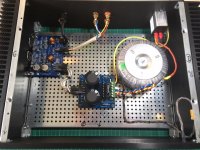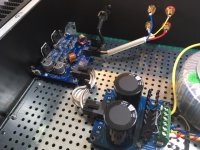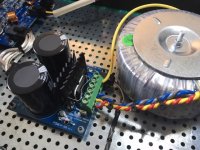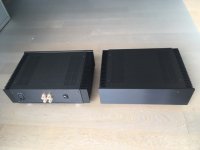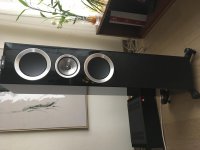After being back from my summer vacation I finished the Mod286s and can announce two new members to our household.
As on indicators I ran the red led from the respective Power86 to the front panel. Other than that it was just mounting the LM3886s to the heat sink, hooking up the XLR input, the speaker wire and crimping the power supply wire 6x12awg from the psu to the Mod286.
Stay tuned for the integration into the audio chain and the listing impressions... let my say upfront... wow or a more cautious not bad all... details to follow the next few days.
As on indicators I ran the red led from the respective Power86 to the front panel. Other than that it was just mounting the LM3886s to the heat sink, hooking up the XLR input, the speaker wire and crimping the power supply wire 6x12awg from the psu to the Mod286.
Stay tuned for the integration into the audio chain and the listing impressions... let my say upfront... wow or a more cautious not bad all... details to follow the next few days.
Attachments
Thanks Tom.
One question. I noticed that the mains voltage here is about 230V (instead of 220V) which in turn brings up the loaded rail voltage from +-35V to ca. 36.7V (measured with my DMM)
Could that be a problem, as you usually specified the Mod286 for 35V? Should I replace the 2x25V Trafos with 2x24V? Are there any performance disadvantages when using the 36.7V rail voltage?
Thanks
One question. I noticed that the mains voltage here is about 230V (instead of 220V) which in turn brings up the loaded rail voltage from +-35V to ca. 36.7V (measured with my DMM)
Could that be a problem, as you usually specified the Mod286 for 35V? Should I replace the 2x25V Trafos with 2x24V? Are there any performance disadvantages when using the 36.7V rail voltage?
Thanks
Last edited:
Your ±37 V will droop to more like ±34-35 under load. I wouldn't worry about it. The absolute maximum voltage for the LM3886 (with signal) and thus the Modulus-286 is ±42 V.
Europe converged on 230 V sometime in the 1990ies. The mains voltage used to be 220 V in Europe, except for the UK which had 240 V. The EU took the average and tightened up the tolerances such that old equipment could still work with 230 V (assuming it could work under the old voltages and broader tolerances). Looks like Switzerland followed the EU.
Tom
Europe converged on 230 V sometime in the 1990ies. The mains voltage used to be 220 V in Europe, except for the UK which had 240 V. The EU took the average and tightened up the tolerances such that old equipment could still work with 230 V (assuming it could work under the old voltages and broader tolerances). Looks like Switzerland followed the EU.
Tom
the EU "harmonised" the mains voltage.Your ±37 V will droop to more like ±34-35 under load. I wouldn't worry about it. The absolute maximum voltage for the LM3886 (with signal) and thus the Modulus-286 is ±42 V.
Europe converged on 230 V sometime in the 1990ies. The mains voltage used to be 220 V in Europe, except for the UK which had 240 V. The EU took the average and tightened up the tolerances such that old equipment could still work with 230 V (assuming it could work under the old voltages and broader tolerances). Looks like Switzerland followed the EU.
Tom
This involved widening the tolerance band for both the 220Vac countries and the 240Vac countries.
We now have a nominal 230Vac +10% and -6%, that includes the ranges that were acceptable in those 220/240Vac countries. Except the UK upper limit was brought down from 254.4Vac to 253Vac.
The UK now quotes the harmonised voltage of 230Vac and generally has stayed with it's 240Vac equipment, but has the tolerance band running from 216Vac to 253Vac.
Mainland EU still has it's former 220Vac equipment and uses the same tolerance band.
The biggest effect was not on the customers, nor on the generators/distributors.
It had a very big effect on the electric and electronics goods manufacturers/importers/retailers.
They now have to supply equipment that works safely and properly on a mains supply that can vary from 216Vac to 253Vac
There are further short term limits that go far outside those +10% -6% limits
Last edited:
Just to clarify my question. I meant are there sound-wise or amp performance advantages or disadvantages with the rail voltage being now about +-36.x vs 35V?
Nah. You've hit the sweet spot for the mono MOD286. Box it up and enjoy it.
Tom
So let’s recap my Mod286 building experience, the materials used, the audio chain integration and ultimately the listening experience
Building:
+ Easy build even for an SMD first timer as I was (however one needs the right solder equipment and some practice boards)
+ Excellent BOM / Mouser Material ordering
+ Super assembly instructions and circuit details (ca. 40 page document)
- Room for improvement (for the metric system users): use an inch value of the mounting screw spacing (Mod286, Power86) which result in a multiple of 10mm +-1mm. E.g. as one of the sides of the Power86 module provides (i.e. 81mm). This would make mounting on the 10x10mm 4mm hole grid of the Modushop cases bottom plate even easier without the need of any drilling.
Materials used:
. 2xMod286 for dual mono configuration with the 20db gain option enabled
. 2xPower86 boards
. 2xAmplimo Toroid 2x25V, 300VA transformers
. 2xModushop Dissipante 3U/300 cases (black), 10mm alu front, 3mm alu panel plus steel internal bottom plate (10x10mm, 4mm hole grid)
. 8x EMC golden speaker posts (for bi-wiring option)
. 4x Neutrik XLR EMC series connectors
. 2x Neutrik XLR DLX sockets
. 2x Schurter IEC C14, filtered mains inlet w/ switch and fuse (DD12 series)
Audio chain:
Source: Auralic Altair Streamer using the XLR outs (max. 4Vrms)
XLR Cable: 1.5m/channel van Damme Starquad XKE
XLR Connectors: Neutrik XLR EMC series connectors
Amp: Mod286 Mono Blocks
Speaker wire: 70cm/channel Atlas Equator MKII bi-wire 6N pure ofc
Speakers: KEF R700
Listening - to follow
Building:
+ Easy build even for an SMD first timer as I was (however one needs the right solder equipment and some practice boards)
+ Excellent BOM / Mouser Material ordering
+ Super assembly instructions and circuit details (ca. 40 page document)
- Room for improvement (for the metric system users): use an inch value of the mounting screw spacing (Mod286, Power86) which result in a multiple of 10mm +-1mm. E.g. as one of the sides of the Power86 module provides (i.e. 81mm). This would make mounting on the 10x10mm 4mm hole grid of the Modushop cases bottom plate even easier without the need of any drilling.
Materials used:
. 2xMod286 for dual mono configuration with the 20db gain option enabled
. 2xPower86 boards
. 2xAmplimo Toroid 2x25V, 300VA transformers
. 2xModushop Dissipante 3U/300 cases (black), 10mm alu front, 3mm alu panel plus steel internal bottom plate (10x10mm, 4mm hole grid)
. 8x EMC golden speaker posts (for bi-wiring option)
. 4x Neutrik XLR EMC series connectors
. 2x Neutrik XLR DLX sockets
. 2x Schurter IEC C14, filtered mains inlet w/ switch and fuse (DD12 series)
Audio chain:
Source: Auralic Altair Streamer using the XLR outs (max. 4Vrms)
XLR Cable: 1.5m/channel van Damme Starquad XKE
XLR Connectors: Neutrik XLR EMC series connectors
Amp: Mod286 Mono Blocks
Speaker wire: 70cm/channel Atlas Equator MKII bi-wire 6N pure ofc
Speakers: KEF R700
Listening - to follow
I got a question for Tom. When looking a while back in the thread at comparable commercially available amps, quite a few times the damping factor was advertised / marketed prominently. So I went back to Google and found out that the length of the speaker wires are having a much greater influence on damping capability, than the amp. Hower just for the sake of completion. Tom do you have that value for the mono Mods286 as well and make it available and put its meaning into perspective?
So I went back to Google and found out that the length of the speaker wires are having a much greater influence on damping capability, than the amp.
I love your realism. You're absolutely right. The speaker wiring, contact resistance, etc. will have far greater impact on the damping factor than the amp.
Hower just for the sake of completion. Tom do you have that value for the mono Mods286 as well and make it available and put its meaning into perspective?
The damping factor is Zload/Zout and is usually provided as a DC measurement - or measurement at a frequency that's practically DC. In case of the Modulus-286 in mono configuration, the output impedance is limited by the output inductors. They're effectively in parallel and each have a DCR of approx. 10 mΩ. So figure the output impedance at DC is around 5 mΩ. Thus, D = 8/0.005 = 1600 for 8 Ω.
Skeptics will argue - and rightfully so - that the resistance of the output connector will be larger than 5 mΩ. Molex specifies 10 mΩ for the tin plated connector and 5 mΩ for the gold plated version. Both of these figures are measured at the rated max current for the connector (23 A). So figure on a damping factor of 8/(0.005+0.005) = 800 if you're using gold plated connectors or 8/(0.005+0.010) = 533 if you're using the tin plated connectors.
I specify tin plated connectors for cost reasons. Nothing prevents you from building the board with gold plated connectors for extra bling (and higher damping factor).
Note that AWG 16 (1.3 mm2) wire has a resistance of 13.17 mΩ/m. AWG 12 (4.0 mm2) gets you down to 5.21 mΩ/m. It should be pretty obvious that even the short wire run inside the chassis from the amp module to the speaker out connectors will impact the damping factor at least as much as the amp itself.
Tom
Last edited:
Listening:
Let me say upfront… it is subjective and highly dependent on our room and speaker setups….
When I got into the project I had an inkling that this could be an improvement to my system. However, if you followed the progress of the project, I had a few doubts along the way (e.g. enough power etc.), which mainly originated from the fact, that I am new to the subject and didn’t clarify all the facts and matched them with my requirements upfront. I also decided, if I spent the time, I want to do it right / perfect and if the result wouldn’t satisfy my expectation, I would try to sell it or write it off as a great learning experience in a field which is fascinating, but in which I didn’t have any background in. Especially I wanted to avoid the effect of being in love with my creations (new kids) and overseeing their possible shortcommings… at least that was the attitude before going into the listening tests.
So I sat down with my wife last Sunday and fired up our new babies and listened for about 4hrs. We then went back last night to redo the exercise in order to confirm / disprove our impressions. Of course it is subjective and non-scientific and not statistically relevant. I didn’t tell my wife which is which amplifier was playing. However…. Wow …. we independently came to the conclusion, that this is a clearly audible improvement. In audio babble one could say “clean, detailed, quick, precise, great soundstage and positioning of instruments” so everything on the high / treble side, non-distortion side these two Mod286s are doing right, if not perfect. The new amps also complement the nicely warm sounding KEFR700s very well (as it was my initial hope) – see the KEF R700 loudspeaker | Stereophile.com review for details. If you were to combine the Mod286 with rather bright sounding speakers, I would recommend to first do a listening test and see if you like what you hear.
On the bass side, we took a little longer to decide. The bass is definitely very controlled. We weren’t sure if it was punchy enough and going deep enough (of course also coming from an amp, which might be skewed in that way). So we went back and forth for a couple of times and I can say the initial impression wasn’t confirmed. The Mod286s have the deep bass and a dry and controlled punchiness, no they don’t emphasize it nor make it even boomy, which is my idea of Hifi. Possibly if one wants to add even more in this arena, the power supply caps could be possibly increased (currently using 2 x 22.000uF per mono block) – however I am not sure on this one and Tom would have to offer an expert opinion, if this might even make a difference.
The power and SPL aspect, which I was so unsure about in the course of the project did turn out to be a non issue to my great relief. When listening we weren’t even using the full power range and were happy at a level (ca. 0.5 to 0.6W average) were it was plenty of loud and still would offer the 20dB dynamic range to the full power level of about 60-64Watts. Of course 0.6W avg. is no disco level, but I find that if I turn it up too loud I am missing some of the subtleties of the music.
To sum it up… no my new Mod286 are definitely not for sale any time soon and we were both wowed by the huge positive difference these two mono block amps brought to our system. We would not have expected such a clearly audible positive difference – in short … we love them.
On the note of conclusion, I would also like to thank the contributors to this thread, especially Tom, who have given me input and advice and patiently addressed my questions and concerns.
Others who might have suggestions or questions please feel free to post here.
Let me say upfront… it is subjective and highly dependent on our room and speaker setups….
When I got into the project I had an inkling that this could be an improvement to my system. However, if you followed the progress of the project, I had a few doubts along the way (e.g. enough power etc.), which mainly originated from the fact, that I am new to the subject and didn’t clarify all the facts and matched them with my requirements upfront. I also decided, if I spent the time, I want to do it right / perfect and if the result wouldn’t satisfy my expectation, I would try to sell it or write it off as a great learning experience in a field which is fascinating, but in which I didn’t have any background in. Especially I wanted to avoid the effect of being in love with my creations (new kids) and overseeing their possible shortcommings… at least that was the attitude before going into the listening tests.
So I sat down with my wife last Sunday and fired up our new babies and listened for about 4hrs. We then went back last night to redo the exercise in order to confirm / disprove our impressions. Of course it is subjective and non-scientific and not statistically relevant. I didn’t tell my wife which is which amplifier was playing. However…. Wow …. we independently came to the conclusion, that this is a clearly audible improvement. In audio babble one could say “clean, detailed, quick, precise, great soundstage and positioning of instruments” so everything on the high / treble side, non-distortion side these two Mod286s are doing right, if not perfect. The new amps also complement the nicely warm sounding KEFR700s very well (as it was my initial hope) – see the KEF R700 loudspeaker | Stereophile.com review for details. If you were to combine the Mod286 with rather bright sounding speakers, I would recommend to first do a listening test and see if you like what you hear.
On the bass side, we took a little longer to decide. The bass is definitely very controlled. We weren’t sure if it was punchy enough and going deep enough (of course also coming from an amp, which might be skewed in that way). So we went back and forth for a couple of times and I can say the initial impression wasn’t confirmed. The Mod286s have the deep bass and a dry and controlled punchiness, no they don’t emphasize it nor make it even boomy, which is my idea of Hifi. Possibly if one wants to add even more in this arena, the power supply caps could be possibly increased (currently using 2 x 22.000uF per mono block) – however I am not sure on this one and Tom would have to offer an expert opinion, if this might even make a difference.
The power and SPL aspect, which I was so unsure about in the course of the project did turn out to be a non issue to my great relief. When listening we weren’t even using the full power range and were happy at a level (ca. 0.5 to 0.6W average) were it was plenty of loud and still would offer the 20dB dynamic range to the full power level of about 60-64Watts. Of course 0.6W avg. is no disco level, but I find that if I turn it up too loud I am missing some of the subtleties of the music.
To sum it up… no my new Mod286 are definitely not for sale any time soon and we were both wowed by the huge positive difference these two mono block amps brought to our system. We would not have expected such a clearly audible positive difference – in short … we love them.
On the note of conclusion, I would also like to thank the contributors to this thread, especially Tom, who have given me input and advice and patiently addressed my questions and concerns.
Others who might have suggestions or questions please feel free to post here.
Attachments
Last edited:
You're welcome. Thank you for your writeup and listening impressions. I appreciate it.
Regarding your impressions of the performance in the bass region: I generally find that when an amp controls the bass really well, it is as if the bass disappears. I find that upon closer listening, all the bass is actually there but all the mud and fuzz is gone. This reveals a level of detail in the bass that I really appreciate.
Tom
Regarding your impressions of the performance in the bass region: I generally find that when an amp controls the bass really well, it is as if the bass disappears. I find that upon closer listening, all the bass is actually there but all the mud and fuzz is gone. This reveals a level of detail in the bass that I really appreciate.
Tom
A question, am I right to assume that increasing the psu caps even further would not make any difference?
Correct.
Tom
As promised and as per recent Forum member request please find attached the DXF drawing of the backplate and its cut-outs. Feel free to use it and adjust it to your particular design. I had to zip the DXF as the forum program does not allow files with DXF extensions.
FYI. For the CAD beginners among you. I used the free LibreCAD to do the drawing. Of course any other DXF capable CAD programm will suffice as well.
You can submit the DXF file to the Modushop by email, after you placed your order online. I also had initially my name and my email address written in the CAD drawings text block so Modushop has it easier to correlate the DXF to my particular order.
Have fun.
FYI. For the CAD beginners among you. I used the free LibreCAD to do the drawing. Of course any other DXF capable CAD programm will suffice as well.
You can submit the DXF file to the Modushop by email, after you placed your order online. I also had initially my name and my email address written in the CAD drawings text block so Modushop has it easier to correlate the DXF to my particular order.
Have fun.
Attachments
- Status
- This old topic is closed. If you want to reopen this topic, contact a moderator using the "Report Post" button.
- Home
- Amplifiers
- Chip Amps
- Mod-286 build thread
